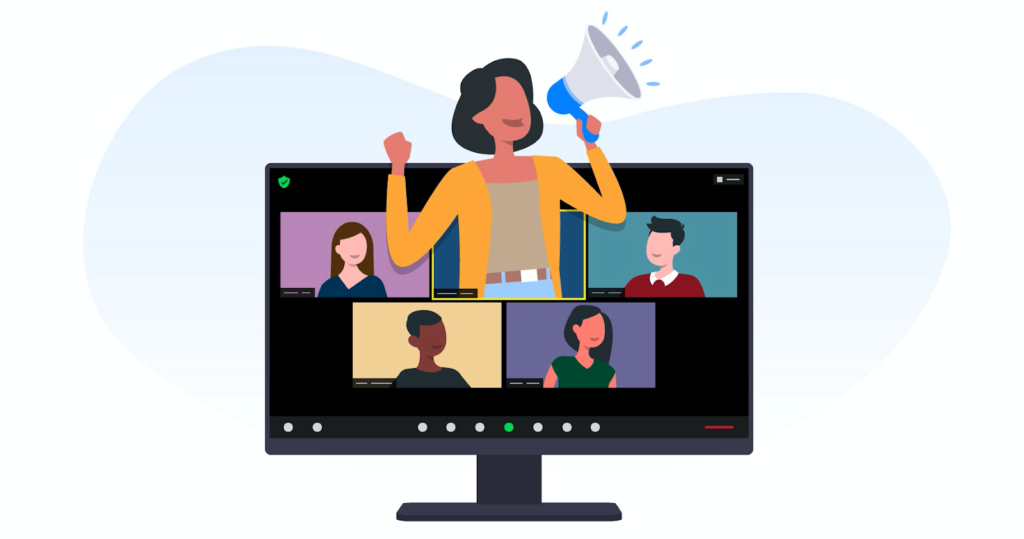Introduction of Dave Clark by David Wagstaff
As part of our series of articles providing stories and insights to entrepreneurs, I met Dave as he joined the Entrepreneur’s Network. For a couple of my businesses, I was considering the use of webinars to provide value for clients and to develop business relationships, and when I ran across Dave’s profile, I knew I had to reach out.
As an entrepreneur, one of the things I find fascinating is how many areas of expertise exist. The internet makes finding very specialized skills available to all. I liked what Dave had to say when we spoke, but we decided it wasn’t an exact fit for that moment. However, we may engage him in the near future.
As I was impressed by Dave’s experience and his focus, I asked if he would like to write one of our expert pieces. The article below is the result, featuring smart tips on how to get the most from your webinars.

Webinar Marketing: Three Important Best Practices for Entrepreneurs.
It’s no surprise that one of the most common applications for webinars is marketing and lead generation. Not only does a webinar offer multiple ways to interact and engage with your prospects and provide them with content, but a webinar also allows you the longest continuous touchpoint you’re likely to have with those prospects. Recently, a webinar benchmarking study found that the average viewing time for a webinar is 57 minutes! With what other type of digital marketing do you have a captive audience for almost an hour? I’ll bet that nobody is reading your blog or visiting your website for that long.
Entrepreneurs can leverage the marketing power of webinars too. Whether the objective is to introduce a new market to your startup, establish your company’s brand, or generate new leads for your nascent business, a webinar offers the ability to easily and inexpensively reach large numbers of people, learn how you can help them, and leverage that insight to grow your business. A webinar strategy can also help establish you as an authority or thought leader in your field, advancing your entrepreneurial venture in the process.
But as with any type of marketing or communications, there’s a certain degree of risk involved with putting yourself out there. A webinar featuring technical problems or poorly developed content will only serve to frustrate and anger potential customers or clients, virtually guaranteeing they won’t want to do business with you. To ensure your webinars end up enhancing your reputation and brand, rather than tarnishing them, here are three important best practices that entrepreneurs should follow when planning and executing a marketing webinar.
-
Don’t Script Your Presentation.
Have you ever registered for a webinar promising an engaging discussion on an exciting topic only to show up and have the presenter read to you from a prepared script? Regardless of how exciting or relevant the topic, reading your entire presentation from a piece of paper is not a very engaging way to communicate. A webinar presentation should have a conversational tone. It shouldn’t be a word-for-word recital.
Rather than scripting your presentation, develop an outline of topics and subtopics and refer to that during your webinar. If you think you need a script to keep track of your material and remember all of your key points, an outline will help you do just that. At the same time, you’ll be able to engage your audience with a conversational tone. That’s what webinar attendees want. They want to feel like they’re participating in a conversation. They don’t want to be read to. If that’s your plan, you might as well just send them your scripted presentation and save them the trouble of attending a webinar.
Once you’ve developed your outline, plan to spend some time practicing and rehearsing. Even though you won’t be using a script, that doesn’t mean you should just wing it. Instead, work on developing a professional, smooth delivery of the material in your outline. You should practice and rehearse until you feel as comfortable as possible with your content and your phrasing, knowing exactly what you’re going to say and how you’re going to say it, but without sounding too formal and stilted.
Many webinar presenters overlook the importance of practicing and rehearsing. Sometimes, it’s an ego thing. I’ve heard presenters say, “I don’t need to rehearse; I’m an expert on my topic.” And that’s true: you are an expert on your topic, which is why you’re entirely capable of engaging your audience in a dialogue rather than reading to them from a prepared script. But don’t neglect the all-important rehearsal phase of webinar presentation development. An audience can easily discern the difference between a webinar presenter who has prepared properly by rehearsing their content and one who’s just phoning it in.
-
Optimize Your Audio.

How your webinar attendees perceive you and your business is heavily influenced by how you sound. If you invite your prospects to a webinar featuring poor audio, forcing them to struggle to hear or understand what you’re saying, don’t count on converting them to new customers.
Indeed, audio is one of the trickiest things to get right during a webinar. Seemingly, it shouldn’t be this way. You can visit your favorite music- or podcast-streaming site right now and enjoy crystal clear broadcast-quality audio. But that’s not how it works with webinars. The audio quality of every webinar is sacrificed in favor of consistent live transmission over the internet to a large group of attendees with various bandwidth capacities. Once the audio is compressed, sent around the world, and received, it usually doesn’t sound as good as when it started. Then, it gets compressed again when the webinar is recorded and processed, decreasing the quality even further.
For these reasons, it’s important to start off on the right foot to begin with. Don’t exacerbate the problem with audio equipment that results in subpar audio from the get-go. The quality of your webinar audio can be “good enough,” but you need to do your part.
You have two choices for your webinar audio: you can speak over the telephone or you can use a computer microphone. Most webinar platforms offer both options, but some of the older platforms still only provide presenters with a telephone audio option while some of the newer platforms provide computer audio only.
Generally, telephone audio is the easiest set-up (everyone has and knows how to use a telephone). But it’s also the safest audio set-up because telephone audio is fed into a webinar broadcast independently of your local internet connection. In other words, even if you lose your internet connection during a webinar, you won’t lose your telephone connection. This redundancy is probably the biggest advantage to using a telephone during a webinar.
If you decide to use telephone audio, don’t use a cell phone. Not only are cell phones less than reliable, but voice quality can suffer from reception issues. You’ll also want to avoid speaker or conference phones. The reverberant room noise produced by those devices is not ideal for a professional-sounding webinar production.
The best option for telephone audio is also the least accessible. Most offices have abandoned landline desk phones and not many people still have landlines at home. But if a landline desk phone is available, take advantage of its superior reliability and voice quality for your webinars.
If you decide to use computer audio, always use a USB microphone, preferably a headset mic. Never use the lousy built-in microphone that your laptop was manufactured with. And make sure your microphone is wired; there should be a cord running from your microphone to your computer. When it comes to webinars, anything wireless should be avoided. In fact, you should also try to tap into a wired internet connection too. Unlike when using a telephone, computer audio is entirely dependent on your internet connection. Instead of using wi-fi, run an ethernet cable from your router to your computer to ensure stability.
Unfortunately, one of the most common complaints cited by webinar attendees is poor audio. With your entrepreneurial reputation on the line, don’t underestimate the importance of setting yourself up to provide clear, reliable audio to your webinar attendees.
-
Keep Your Promises.
This seems like an obvious best practice. But it’s amazing how many webinars make promises and then fail to deliver on them. At the very least, doing so will end up annoying your prospects. At worst, you and your business will lose all credibility with them.
Typically, there are two ways in which you can fail to keep your promises during a webinar. The first way is relatively minor: your webinar invitation promises specific insights or takeaways, but the presenters forget about one or two of them or run out of time and skip a few. This results in an unsatisfied or frustrated audience—not the reactions you’re looking for from a prospect list.
There should be consistency in your messaging from the invitation to registration to the webinar itself. If your webinar will feature multiple presenters, make sure that everyone is on board with the promises of value and that their content reflects it. Try to deliver your most important takeaways early in your presentation so that attendees will still receive what they were promised even if they need to leave early or you run low on time.
The other type of webinar offense can be perceived by an audience as a major breach of trust: your webinar invitation highlights the education and value that will be gained by attendees but all they get when they show up is a blatant sales pitch.
Unless you’re hosting a bottom-of-the-funnel sales presentation, where the audience is expecting a sales pitch, try to resist the temptation to actively sell during your webinar. Instead, focus on value like education and thought leadership, if that’s what your audience was promised. Many “marketing” webinars never once mention a product or service, or even the name of a company. Or if they do, it’s very subtle. Even if the ultimate goal of your webinar is to promote your company or generate new leads for your business, the objective of your webinar is to provide education and value and establish yourself as an industry leader. As a result, when your prospects are ready to buy, you’ll be the first one they think of.
Webinars are one of the most effective and economical ways for entrepreneurs to reach a target market or grow a brand. But if your webinars are making false promises or employing bait-and-switch tactics, you’ll only end up damaging your credibility and alienating your prospects. Always keep your word and check your selling instincts at the door.
About Dave Clark
Website: Clark Webinar Consulting
Dave Clark is the founder of Clark Webinar Consulting, providing personalized, solution-oriented expertise and support to help businesses, nonprofits, and other organizations benefit from and deliver professional webinars. With over 10 years of hands-on webinar experience, CWC provides a wide range of webinar-related solutions including complete webinar production and support services. For more information, please visit ClarkWebinar.com.

